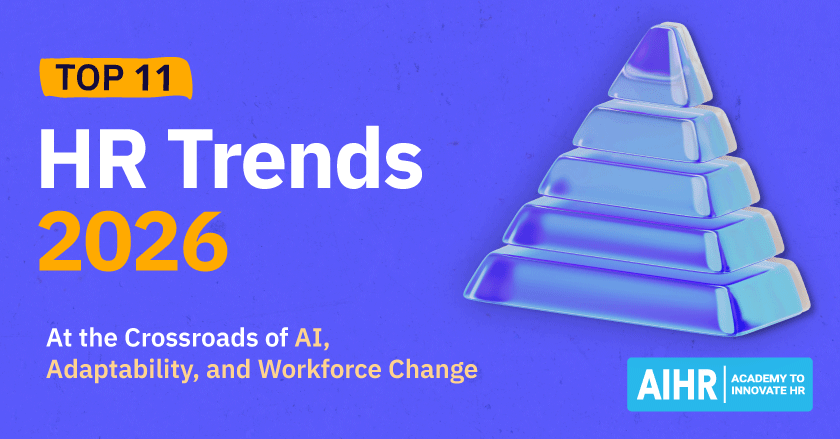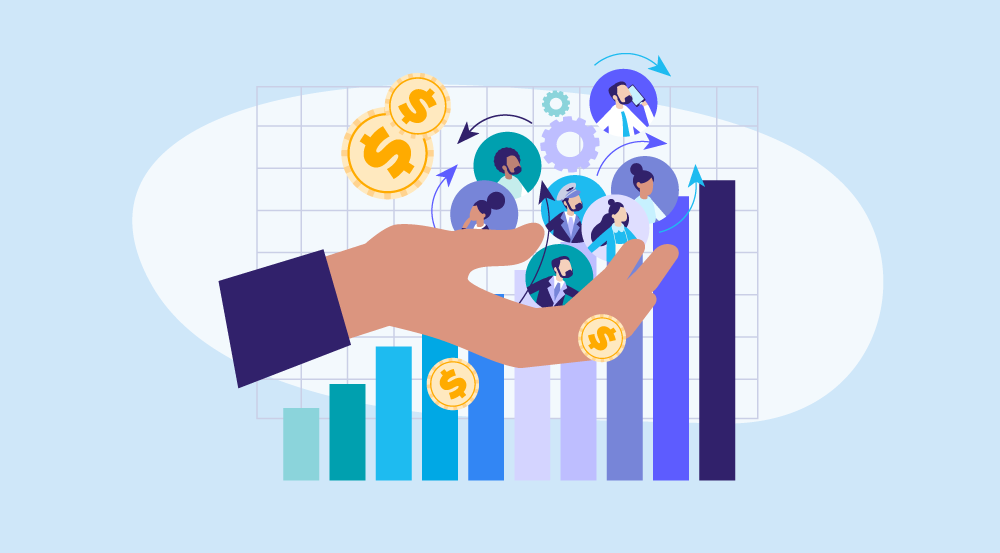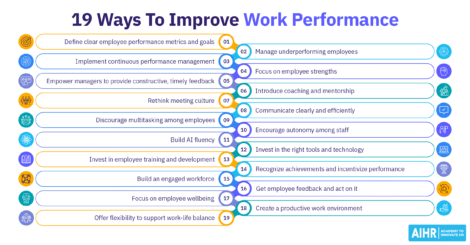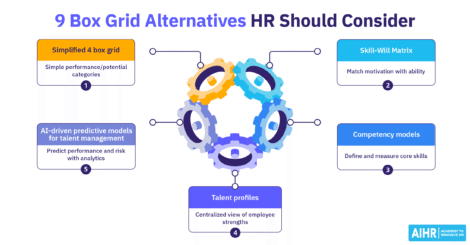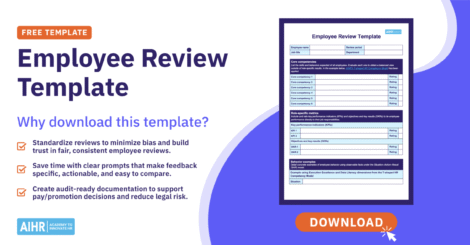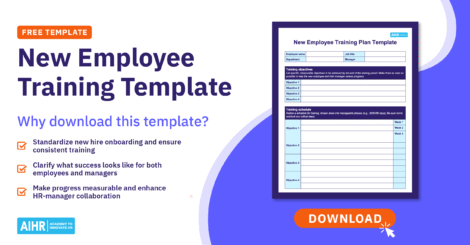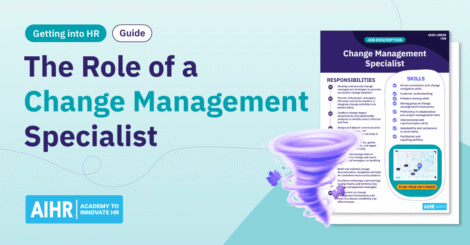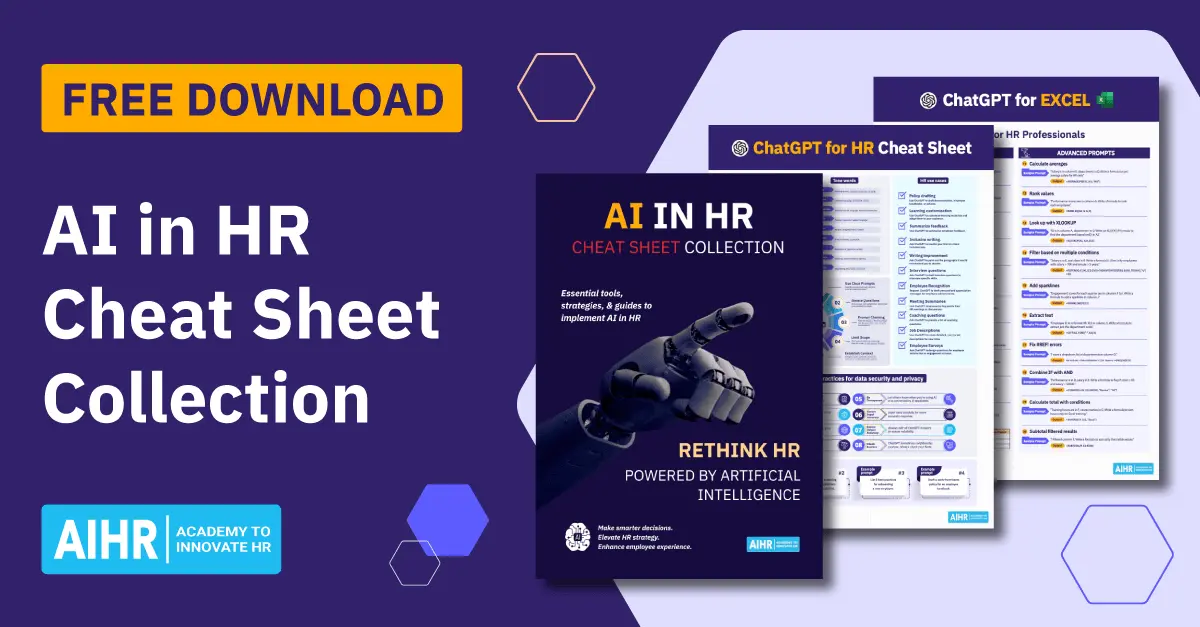Is your organization making the most of the benefits of strategic workforce planning (SWP)? Analysis by Korn Ferry suggests that by 2030, there will be a shortage of 85 million employees and increased competition for talent among businesses. Strategic workforce planning can help businesses move from being reactive to agile and stay ahead in the war on talent, anticipating future changes so that they always have the right people with the right skills in the right roles at the right time.
Let’s explore the benefits of strategic workforce planning and how this process can help organizations stay competitive, innovative, and ready for an ever-evolving world of work.
Contents
Aligning workforce strategies with business objectives
Enhancing organizational agility
Improving resource allocation and utilization
Cost efficiency
Boosting employee retention and engagement rates
Mitigating risks associated with talent shortages
Optimizing the recruitment process for quality hires
Future-proofing skills
Investing in top talent
Creating a more diverse and inclusive workforce
Improving workforce productivity
Enhancing employee experience
1. Aligning workforce strategies with business objectives
Strategic workforce planning helps align your people strategy with long-term business goals so that talent decisions directly support the organization’s direction.
Start by asking:
- What are the long-term objectives of the business?
- Where does it aim to go and grow over the next three to five years?
- Are you planning to launch a new product, change direction with your offering, or launch in a new country or territory?
- To what extent are you planning to leverage technology to streamline operations and improve efficiency?
The answers to these questions will help you pinpoint your long-term business goals. Once you have identified these goals, you start building a strategically prepared workforce with the right skills, experience, and values to help you achieve them.
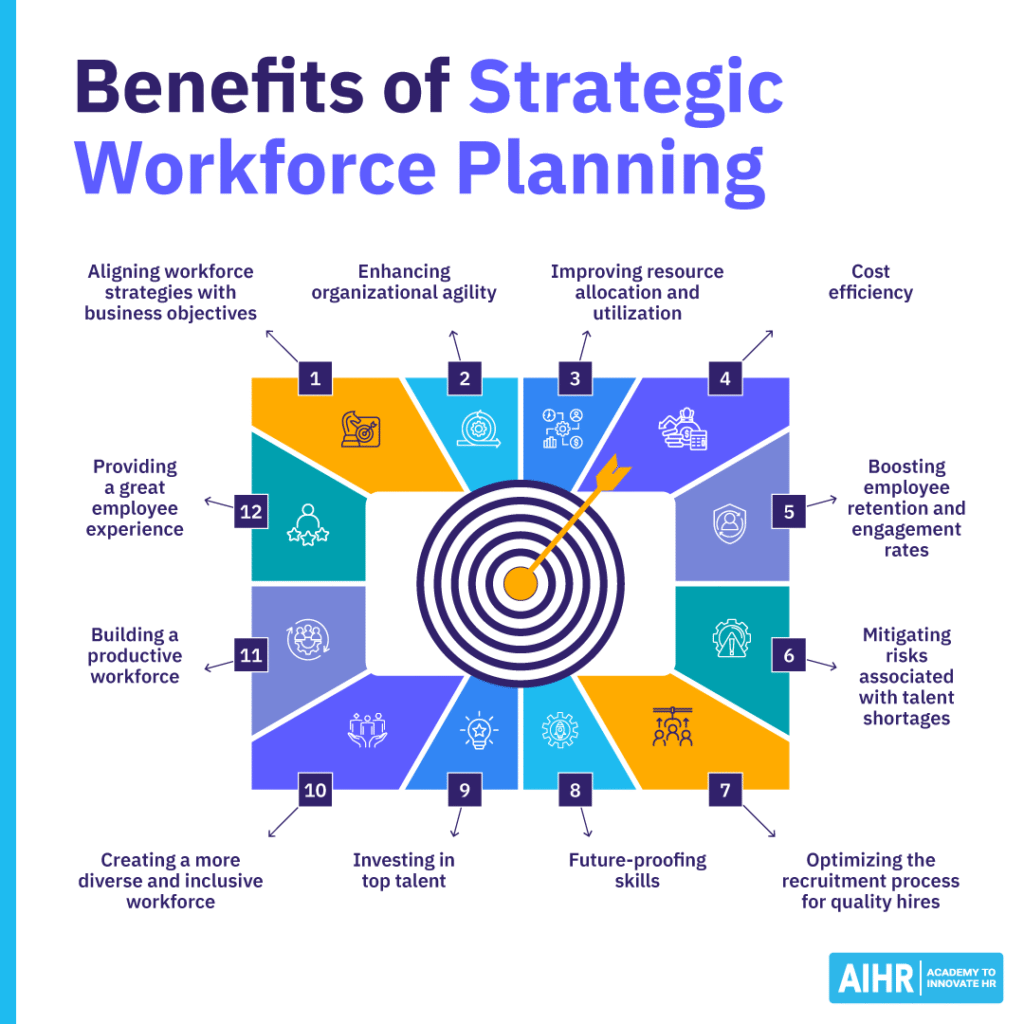
2. Enhancing organizational agility
One of the benefits of strategic workforce planning is that it enables HR teams and business leaders to predict short and long term requirements to meet goals, anticipate future talent needs, and adapt quickly to market shifts.
With technology – particularly the advancement of generative AI – rapidly evolving and the job market being difficult to predict, organizations that are ready to adapt quickly to unforeseen changes will have a strong advantage over reactive and inflexible organizations. It’s predicted that as many as 14% of employees may need to change their careers by 2030 due to digitization and AI advancements.
Organizations that build agility through strategic workforce planning stay ahead of change, redeploy talent where it’s most needed, and maintain stability even as roles and skill requirements continue to shift.
Strategic workforce planning at Amazon
Amazon’s workforce planning strategy combines innovative hiring with continuous learning and internal mobility. The company focuses on identifying emerging skills, supports employees in moving into new roles, and partners with community colleges and nonprofits to align workforce growth with evolving business needs.
3. Improving resource allocation and utilization
With a strategic workforce planning strategy, people teams gain more clarity on the current skills of their workforce so they can better manage staff levels in alignment with upcoming projects and business demands, and ensure that talent supply is equal to demand.
HR may discover that certain teams could greatly benefit from additional staff to reach their potential, or that a specific number of new hires in the lead-up to a new product launch could help drive revenue. An effective workforce strategy means identifying any talent gaps and working to fill them so that the organization always has the right resources in the right roles when needed, reducing underuse or overload.
Power your talent strategy with the right skills
Strategic workforce planning starts with understanding your current talent and making informed decisions about what’s needed next. To do that effectively, you need skills in analyzing talent data, frameworks, and forward-looking strategy.
With AIHR’s Talent Management Certificate Program, you’ll learn to:
✅ Foster a consistent, positive talent experience across the employee life cycle
✅ Build talent pipelines and succession plans that future-proof your organization
✅ Leverage internal mobility and career paths to engage and retain top talent
✅ Connect day-to-day talent practices to long-term strategic planning
🎓 Gain the skills to manage today’s talent and plan for tomorrow’s.
4. Cost efficiency
Hiring and losing employees requires significant financial resources, but strategic workforce planning can reduce these costs. With the right forecasting tools, businesses can predict future staffing needs and the resources required to maintain optimum productivity levels to reduce overstaffing, reliance on expensive overtime, and lower labor costs.
In addition, analyzing staffing data next to the additional roles you need to hire for helps people teams better understand the roles they need to fill and the unique mix of skills, knowledge, and behaviors required for those positions.
With this clearer insight, recruiters are able to bring the right people into the organization the first time around, reduce the time that positions are unfilled as well as last-minute hiring, and benefit from having skilled employees on board who help the business meet long-term objectives.
5. Boosting employee retention and engagement rates
Research by the Pew Research Center found that 63% of workers quit their jobs due to a lack of career advancement opportunities. One of the key benefits of strategic workforce planning is that it helps organizations provide training and upskilling opportunities to employees to develop internal talent and provide clear career paths for growth. In turn, this helps keep employees satisfied and motivated at work, which helps improve engagement and retention rates.
It’s estimated that low engagement levels cost businesses $8.8 trillion each year in lost productivity. By demonstrating to your people that you’re committed to nurturing their careers, providing training, and recognizing and rewarding great work, they’ll feel supported and valued, and are much more likely to stay with their employer for longer.
6. Mitigating risks associated with talent shortages
The right workforce plan can help businesses anticipate potential talent shortages early on, adapt to changing needs, and thereby mitigate workforce risks. With an effective plan in place, you can build talent pipelines to prevent disruption in the workplace.
For example, workforce planning can help you identify that many members of your senior leadership team will be retiring over the next five years. With this insight, you can start to develop a succession plan, identify future potential leaders in the organization now, and begin to develop them so they’re ready to step into those roles when the time comes.
7. Optimizing the recruitment process for quality hires
Strategic workforce planning can reveal the skills, knowledge and behavioral traits your workforce currently lacks or will need in the near future. Workforce data can create a picture of the skills and values that all your top performers share, and recruiters can use this information as clear criteria when writing job descriptions, assessing candidates, and making hiring decisions.
This helps attract candidates who align with the values and goals of the organization, reduce time to fill, and increase the chances of hiring qualified employees who will help drive the business forward.
8. Future-proofing skills
By forecasting the future needs of the business and the changing world of work (particularly the evolution of technology), HR teams can anticipate emerging skill needs and develop strategic workforce plans to upskill and reskill staff and future-proof the entire workforce. This approach enables you to retain high performers, support their career growth, outperform your competition, and build a workforce that’s ready to grow with your organization.
Strategic workforce planning at an oil & gas company
In a tech-driven oil and gas company, strategic workforce planning revealed that nearly 50 roles were critical to future operations—far more than the ten the business had previously identified. To close emerging capability gaps, the company launched large-scale reskilling programs to prepare traditional operations talent for new, technology-enabled drilling methods.
The organization introduced a real-time dashboard that allowed HR and business leaders to track progress and stay aligned on workforce priorities. It also upskilled the HR team in data analytics, scenario modeling, and strategic planning so they could take a more proactive, evidence-based approach to workforce decisions.
9. Investing in top talent
Another major benefit of strategic workforce planning is that, through reviewing performance evaluations and other relevant data, you can learn who your most valuable, top-performing employees are, and analyze if any of them are at risk of leaving the business.
With this information, HR teams can recognize and reward employees for their commitment and work, and identify who deserves a raise, promotion, or bonus. Rewarding high performance can be an effective retention strategy, and it motivates and encourages other employees to perform at their best.
10. Creating a more diverse and inclusive workforce
Strategic workforce planning can help HR teams identify representation gaps and develop hiring strategies that reduce unconscious bias and help to close these. When your recruitment journey helps you attract and hire candidates from diverse backgrounds, you’re increasing the range of skills and experiences amongst your team, and improving creativity and innovation. Plus, a workforce comprised of diverse ideas and perspectives helps you better cater to a diverse customer base.
11. Improving workforce productivity
By balancing headcount with demand, the overall productivity of your workforce can reach its potential. Employees are no longer overwhelmed with too much work and at risk of burnout, and each person can focus on completing the high-value work of their role. Not only does this mean that all employees can be more productive, but it also makes the business better equipped to meet its goals.
12. Enhancing employee experience
Improved employee experience is a significant benefit of strategic workforce planning, and there are several ways this occurs.
With clearer hiring criteria, the recruitment process is more streamlined and creates a more positive first impression. Ensuring that teams always have the right number of people with the right skills to perform, everyone is able to focus on their own tasks and work together to meet goals. Through offering more training and development opportunities to employees, people feel valued, and career paths and progression within the company become clearer. By recognizing and rewarding employees for their hard work, appreciation levels rise.
All of these changes help to enhance the overall employee experience.
To sum up
Strategic workforce planning offers organizations many benefits, including the ability to adopt an agile approach, improve the way resources are allocated and used, and future-proof the workforce’s skills. By aligning your people with the values and long-term objectives of the business, you’re maximizing engagement and productivity, and the business grows stronger and more resilient to future challenges.


